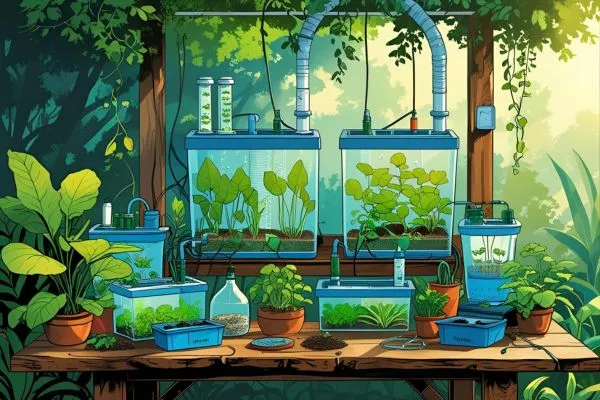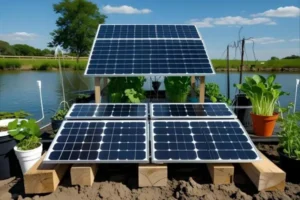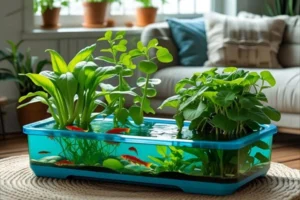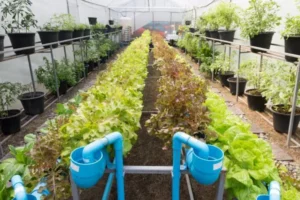The aquaponics industry has experienced remarkable growth, with market projections showing a compound annual growth rate of 12.3% through 2028. This surge reflects growing interest in sustainable food production, water conservation, and self-sufficiency. However, despite this enthusiasm, one of the biggest hurdles facing aspiring aquaponics practitioners is the overwhelming confusion about which supplies are truly essential versus those that are merely “nice to have.”
Many beginners find themselves paralyzed by endless equipment lists, conflicting advice from various sources, and the fear of making costly mistakes. Some purchase expensive, unnecessary equipment while overlooking crucial components, leading to system failures and frustration. Others get caught in “analysis paralysis,” spending months researching without ever getting started.
This comprehensive guide eliminates that confusion by providing a clear, organized breakdown of aquaponics supplies categorized by function and necessity level. Whether you’re planning a small-scale hobby system on your balcony or considering a larger backyard setup, you’ll discover exactly what equipment you need, why you need it, and how to prioritize your investments for maximum success and value.
Essential Water System Components
The heart of any aquaponics system lies in its water circulation network, making these components absolutely critical for success. Your water system supplies ensure proper nutrient flow, oxygenation, and the biological processes that make aquaponics possible.
Water pumps and circulation equipment form the circulatory system of your setup. For small hobby systems up to 100 gallons, a reliable submersible pump rated at 200 to 400 GPH (gallons per hour) typically suffices. Popular options include the VIVOSUN 400 GPH submersible pump priced between 25 to 35 dollars or the EcoPlus 396 costing 40 to 50 dollars. For larger systems exceeding 200 gallons, consider external pumps like the Danner Mag-Drive series, which offer better efficiency and easier maintenance. Always select pumps with flow rates 2 to 3 times your total system volume per hour.
Plumbing supplies and fittings connect your entire system. Essential items include PVC pipes typically ¾ inch to 2 inches in diameter, elbow joints, T-fittings, ball valves for flow control, and unions for easy disconnection during maintenance. Food-grade tubing and barbed fittings work well for smaller systems. Do not forget essential components like bulkhead fittings for tank connections and check valves to prevent backflow.
Water testing kits and monitoring tools are non-negotiable for system health. The API Master Test Kit priced between 25 to 30 dollars covers ammonia, nitrite, nitrate, and pH which are the fundamental parameters. Digital pH meters like the Apera Instruments PH20 costing 50 to 70 dollars provide more accurate readings than test strips. For serious practitioners, consider investing in TDS meters, dissolved oxygen meters, and automated monitoring systems.
Growing Infrastructure and Media
Your growing infrastructure determines plant health, system efficiency, and harvest success. These supplies create the environment where your vegetables and herbs will thrive throughout their lifecycle.
Grow beds and containers serve as the foundation for plant cultivation. IBC totes measuring 275 to 330 gallons cut in half make excellent, affordable grow beds for larger systems, typically costing 100 to 150 dollars when purchased used. For smaller setups, food-grade storage containers, wooden raised beds lined with pond liner, or purpose-built aquaponics grow beds work effectively. Ensure beds are 12 to 18 inches deep for most vegetables, with proper drainage via standpipes or bell siphons. The flood-and-drain method requires beds that can handle water level fluctuations without structural damage.
Growing media options provide plant support and biological filtration. Expanded clay pebbles also known as hydroton remain the gold standard, offering excellent drainage, pH neutrality, and beneficial bacteria colonization surface. Expect to pay 0.50 to 1.00 dollars per liter. Alternatives include pea gravel that has been thoroughly washed, coconut coir mixed with perlite, or specialized aquaponics media like Growstones. Avoid limestone-based materials that affect pH, and ensure all media is thoroughly rinsed before use.
Plant support systems become crucial as plants mature. Bamboo stakes, tomato cages, and trellising systems support heavy fruiting plants like tomatoes, peppers, and cucumbers. Wire mesh panels create excellent climbing structures for vining crops. For leafy greens in NFT or DWC systems, net pots measuring 2 to 3 inches in diameter and growing cubes provide essential root support. Quality support systems prevent plant damage and maximize growing space efficiency.
Fish Tank and Aquatic Equipment
The aquatic component of your system houses the fish that provide essential nutrients for plant growth. Selecting proper fish tank and aquatic equipment ensures healthy fish populations and optimal nutrient production for your crops.
Tank selection and sizing forms the foundation of your aquatic system. For hobby systems, food-grade plastic tanks ranging from 100 to 300 gallons work excellently. Rubbermaid stock tanks measuring 100 gallons typically cost 150 to 200 dollars and suit most backyard setups. Larger operations benefit from 300 to 500 gallon polyethylene tanks priced between 300 to 600 dollars. Calculate fish density at 1 pound of fish per 5 to 10 gallons of water for optimal health. Round tanks promote better water circulation than rectangular ones, though both function adequately with proper design.
Aeration and oxygenation supplies maintain critical dissolved oxygen levels above 5 ppm. Air pumps like the EcoAir series ranging from 40 to 120 dollars depending on capacity provide reliable performance. Combine these with air stones, weighted airline tubing, and check valves to prevent water backflow. For larger tanks, venturi valves and diffusion systems offer more efficient oxygenation. Battery backup systems become essential for preventing fish loss during power outages.
Fish feeding and care equipment ensures healthy fish populations. Automatic fish feeders priced between 30 to 80 dollars maintain consistent feeding schedules when you travel. Fish nets, quarantine tanks measuring 20 to 40 gallons, and water heaters for temperature-sensitive species like tilapia complete essential equipment lists. Keep backup heaters rated for your tank size, as temperature fluctuations stress fish significantly. Basic first aid supplies including aquarium salt and anti-bacterial treatments help address common fish health issues quickly.
Environmental Control Systems
Environmental control systems maintain optimal growing conditions regardless of external weather or seasonal changes. These supplies become particularly crucial for indoor systems and year-round production in challenging climates.
Lighting solutions for indoor systems replace natural sunlight for plant photosynthesis. LED grow lights offer the best efficiency and longevity for aquaponics applications. Full-spectrum LED panels measuring 2 feet by 2 feet typically cost 80 to 150 dollars and cover 4 to 6 square feet of growing space effectively. For leafy greens, aim for 20 to 30 watts per square foot of growing area. Fruiting plants like tomatoes and peppers require 30 to 50 watts per square foot for optimal production. Popular options include the Spider Farmer SF series and Mars Hydro panels. Timer controls costing 15 to 25 dollars automate lighting schedules, providing plants with consistent 12 to 16 hour photoperiods.
Temperature control equipment maintains fish and plant health across seasons. Aquarium heaters rated for your tank volume prevent fish stress in cold weather. Titanium heaters priced between 40 to 80 dollars resist corrosion better than glass alternatives. For cooling, fans and evaporative coolers work in dry climates, while chillers become necessary in extremely hot regions. Greenhouse thermostats costing 50 to 100 dollars automatically control heating and cooling systems.
pH adjustment supplies maintain the critical 6.8 to 7.2 pH range optimal for nutrient absorption. Potassium hydroxide raises pH safely, while phosphoric acid lowers it without harming beneficial bacteria. Purchase food-grade chemicals in small quantities initially, as small amounts create significant pH changes. pH buffer solutions stabilize readings and cost 10 to 20 dollars per bottle. Digital pH controllers priced between 100 to 300 dollars automatically dose adjustment chemicals, though manual testing and adjustment works perfectly for smaller systems.
Budget-Friendly DIY Supply Alternatives
Building an aquaponics system on a budget requires creativity and resourcefulness. These cost-effective alternatives can reduce startup costs by 40 to 60 percent while maintaining system functionality and safety.
Repurposed household items offer excellent substitutes for expensive specialized equipment. Large plastic storage containers measuring 18 to 27 gallons work perfectly as fish tanks for small systems, costing 15 to 30 dollars instead of 100 dollars for aquarium tanks. Food-grade buckets from restaurants or bakeries serve as grow beds when properly modified with drainage holes. Old aquarium pumps, air stones, and filters from previous fish-keeping endeavors function excellently in aquaponics applications. Kitchen colanders and mesh baskets substitute for expensive net pots when growing leafy greens.
Cost-effective substitutions maintain quality while reducing expenses significantly. Instead of purchasing 50 dollar pH meters, reliable liquid test kits costing 8 to 12 dollars provide adequate accuracy for beginners. Automotive air pumps designed for fish tank use cost 20 to 35 dollars compared to 60 to 100 dollars for aquarium-specific models. PVC fittings from hardware stores cost 70 percent less than hydroponic specialty suppliers while offering identical functionality. Pool supply stores sell the same chemicals used for pH adjustment at fraction of hydroponic retailer prices.
Where to find discounted supplies requires strategic shopping across multiple sources. Facebook Marketplace and Craigslist offer used IBC totes, aquarium equipment, and greenhouse supplies at 30 to 50 percent below retail prices. Restaurant supply stores sell food-grade containers and equipment without the markup of specialty retailers. End-of-season sales at garden centers provide pumps, timers, and growing supplies at clearance prices. Local fish stores often discount slightly damaged equipment that functions perfectly for aquaponics use. Building relationships with commercial aquaculture operations sometimes yields free or low-cost used equipment during system upgrades.
Recommended Suppliers and Shopping Tips
Strategic purchasing from reliable suppliers ensures quality equipment at competitive prices while avoiding common beginner mistakes and costly delays in system construction.
Online vs local retailers each offer distinct advantages for different supply categories. Amazon provides excellent selection and competitive pricing for basic equipment like pumps, test kits, and plumbing supplies, often with 15 to 25 percent savings compared to specialty stores. However, shipping costs can add 20 to 40 dollars for heavy items like tanks and growing media. Specialty aquaponics retailers such as Aquaponics USA and Nelson and Pade offer expert advice and system-specific components but typically charge 20 to 30 percent premiums. Local farm supply stores excel for bulk purchases like fish food and growing media, often matching online prices without shipping fees.
Seasonal purchasing strategies maximize savings and ensure availability. Purchase heating equipment during summer clearance sales, saving 30 to 50 percent on aquarium heaters and greenhouse heating systems. Spring represents peak pricing for most gardening supplies, while fall clearances offer significant discounts on pumps, timers, and containers. Black Friday and end-of-year sales provide excellent opportunities for LED grow lights and monitoring equipment. Order fish during moderate weather months to reduce shipping stress and mortality rates.
Quality evaluation criteria prevent costly mistakes and equipment failures. Research customer reviews focusing on longevity and reliability rather than just price comparisons. Verify pump flow rates match manufacturer specifications through independent testing reviews. Check warranty terms carefully, as quality suppliers offer minimum 1 to 2 year coverage on major components. Avoid suppliers with poor customer service reputations, as aquaponics often requires technical support during system setup. Request detailed specifications sheets for expensive items like controllers and monitors to ensure compatibility with your specific system requirements.
Conclusion
Building a successful aquaponics system starts with selecting the right supplies that balance quality, functionality, and budget considerations. Throughout this comprehensive guide, we have explored the essential components that transform basic materials into thriving food production systems.
Smart supply selection forms the foundation of aquaponics success. Water system components ensure proper circulation and monitoring, while growing infrastructure provides optimal plant environments. Fish tanks and aquatic equipment maintain healthy populations that drive nutrient production. Environmental control systems extend growing seasons and enable indoor cultivation. Most importantly, budget-friendly alternatives and strategic purchasing make aquaponics accessible regardless of financial constraints.
Quality over quantity remains the guiding principle when building your supply list. Investing in reliable pumps, accurate testing equipment, and proper filtration prevents costly system failures and fish losses. However, creative substitutions and DIY alternatives prove that expensive specialized equipment is not always necessary. Many successful systems operate effectively using repurposed materials and basic components from hardware stores.
Your aquaponics journey begins with understanding these supply fundamentals, but success comes through practical application and continuous learning. Start small with essential components, then expand your system and upgrade equipment as experience grows. Focus on mastering water quality management and fish care before adding complex automation or specialized growing techniques.
The sustainable food production revolution happening in backyards, greenhouses, and urban spaces worldwide starts with individuals like you taking the first step. Every successful aquaponics system began with someone researching supplies, making their first purchases, and committing to learning through hands-on experience.
What supplies are you planning to purchase first for your aquaponics system? Share your supply list and budget in the comments below, and let us know which components you found most helpful from this guide. Connect with fellow aquaponics enthusiasts and get advice on the best suppliers in your area. Your sustainable food production journey starts with taking that first step today!
FAQ – Frequently Asked Questions
How much does it cost to set up a basic aquaponics system with all necessary supplies?
A complete starter system for 2 to 4 people typically costs 300 to 800 dollars depending on size and component quality. Basic 100-gallon systems using DIY materials can start around 200 to 300 dollars, while commercial kits range from 500 to 1,500 dollars. The biggest expenses are usually the fish tank, grow beds, and pump system.
What are the absolute essential supplies I need to start my first system?
Your core supplies include a fish tank measuring 100 to 200 gallons, grow beds, water pump rated for your system volume, growing media like expanded clay pebbles, basic plumbing connections, and water testing kit for pH, ammonia, nitrite, and nitrate. Everything else can be added gradually as your system develops.
Can I use regular aquarium equipment instead of specialized aquaponics supplies?
Absolutely! Standard aquarium pumps, heaters, air stones, and test kits work perfectly in aquaponics systems. Often they cost 20 to 40 percent less than specialized equipment while offering identical functionality. Just ensure all materials are food-safe if they contact edible plants.
How long do aquaponics supplies typically last before needing replacement?
Quality water pumps last 3 to 5 years with proper maintenance, while growing media like clay pebbles can last indefinitely with occasional cleaning. Test kits require replacement every 12 to 18 months, and pH adjustment chemicals as needed. Invest in durable components for longer-term savings.
Do I need to purchase all supplies at once, or can I build gradually?
Start with essential water circulation and testing supplies, then add components as your system stabilizes. Many successful growers begin with basic setups costing 200 to 400 dollars, then upgrade equipment and expand capacity over 6 to 12 months based on experience and results.



